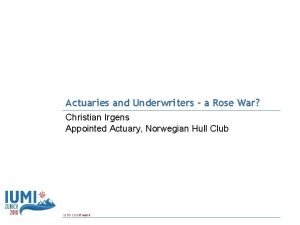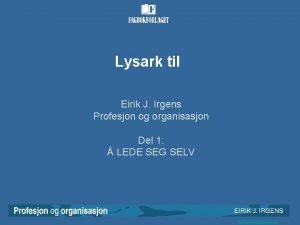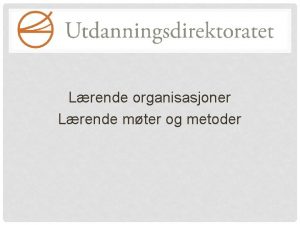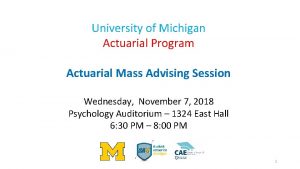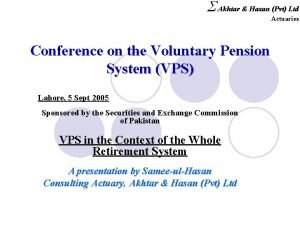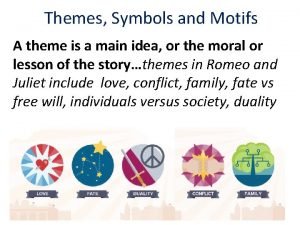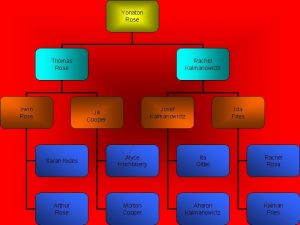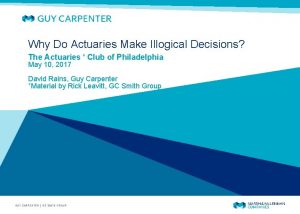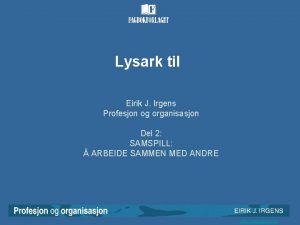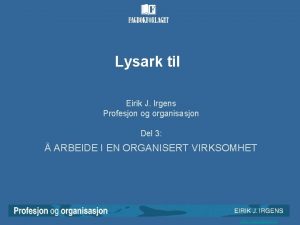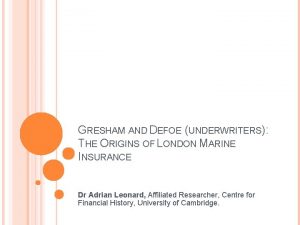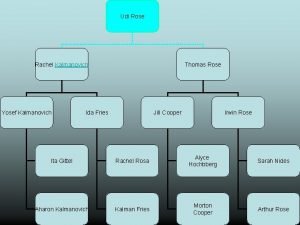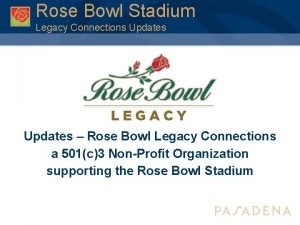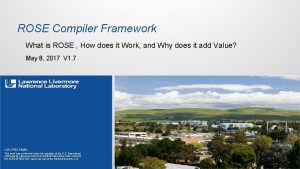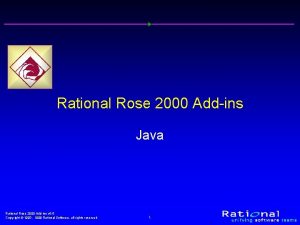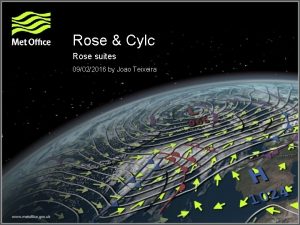Actuaries and Underwriters a Rose War Christian Irgens

























- Slides: 25

Actuaries and Underwriters - a Rose War? Christian Irgens Appointed Actuary, Norwegian Hull Club 12 TO 15 SEPTEMBER

THE WARS OF THE ROSES? ? • • • A civil war (House of York versus Lancaster) A war finished a long time ago (1487) Red and white roses symbols of the parties Partly caused by the King’s periodical insanity Some friends portrayed as more annoying than enemies (Edmund Blackadder) • A distant relative of one part brought an end to the war (Henry Tudor) 12 TO 15 SEPTEMBER 2

IUMI ROSE WAR? • • • A civil war A war finished a long time ago Red and white rose a symbol of IUMI Partly caused by the UW’s periodical insanity Some friends portrayed as more annoying than enemies (Actuaries) • A distant relative of one part brought an end to the war (Bill Gates) 12 TO 15 SEPTEMBER 3

WHY SPEND 1 OF 15 MINUTES ON THE ABOVE? Insignificant arguments: • To honour the title of the session • When 1 against 500 facts are of the essence • To prove actuarial ignorance of American comedies Significant argument: • There is no event for which you can’t come up with a plausible explanation in hindsight… Why refer to medieval England in the title? Why did the stock market drop 1% today? Why has client A got a clean record? Why has client B got a bad record? Most likely: A pure coincidence 12 TO 15 SEPTEMBER 4

HULL & MACHINERY 1985 -2007 (Cefor) H&M characteristics: • Volatility • Cyclicality • Long term losses 150 % 180, 000 160, 000 140, 000 120, 000 100 % 80, 000 60, 000 50 % 40, 000 Changing risk Self-inflicted volatility & losses 0% 20, 000 0 1985 1986 1987 1988 1989 1990 1991 1992 1993 1994 1995 1996 1997 1998 1999 2000 2001 2002 2003 2004 2005 2006 2007 Loss Ratio 200 % 200, 000 12 TO 15 SEPTEMBER Loss Ratio Claim Premium 5 USD Premium and Claim per Vessel 250 %

PREMIUM FOR 100 VLCCs OF 250 -299’ DWT 25 IUMI$ Premium per Vessel 20 15 10 Sample of fairly homogeneous tonnage: • Huge premium differentiation • Limited correlation with vessel details! • No vessels with average premium! 5 0 2001 2002 12 TO 15 SEPTEMBER 2003 2004 2005 2006 2007 2008 2009 6

UWY 2006 VLCC Premium Distribution 30 Market perspective: Very good, bad, very bad Model perspective: Good, average, bad True perspective: A mix of the two Number of vessels 25 20 15 10 5 -1 05 10 5% % -1 15 11 5% % -1 25 12 5% % -1 35 13 5% % -1 45 14 5% % -1 55 15 5% % -1 65 16 5% % -1 75 17 5% % -1 85 18 5% % -1 95 19 5% % -2 05 % 5% 95 % % -9 5% 85 % -8 5% 75 -7 65 % 55 % -6 5% 0 Vessel Premium / Average Premium 12 TO 15 SEPTEMBER Market Model 7

OBSERVATIONS • Volatile premium in periods of stable claims • Long term insufficient premium • Huge premium differentiation for identical risks! “There is no such thing as a VLCC market premium” • All risks are priced as (very) good or (very) bad! • Zurich we have a problem… • Who’s to blame? Actuaries have been less involved in running marine insurance companies than running them off… 12 TO 15 SEPTEMBER 8

VALUABLE BUT CONFLICTING PERSPECTIVES The Underwriter/Market The Actuary/Model • Clients / brokers Client claims Client profitability • Gut feelings • Optimism (or pessimism) • Dining and w(h)ining • Portfolios and risks Portfolio claims Portfolio profitability • Statistical analysis • Cynicism • Nothing to do but work… 12 TO 15 SEPTEMBER 9

GOOD FLEET STATISTICS… • Do they exist? Not even a clean record is necessarily significantly better than average • As long as a client has no claims the underwriter has limited insight into the client’s operations As long as a client has no claims the underwriter searches for (and finds) reasons for the good performance and ignore latent risks • As long as a client has no claims the client might become complacent • As long as a client has no claims he is able to negotiate a discount • Fleets with good statistics are not necessarily bad(!); but are seldom as good as they seem and will usually become poorly priced 12 TO 15 SEPTEMBER 10

BAD FLEET STATISTICS… • Do they exist? Yes – the sky is the limit… • As long as a client has no claims the underwriter has limited insight into the client’s operations As long as a client has no claims the underwriter searches for (and finds) reasons for the good bad performance and ignore latent risks the rest • As long as a client has no claims the client might not become complacent (and might learn) • As long as a client has no claims he is not able to negotiate a discount • Fleets with bad statistics are not necessarily good, but can be and/or become good 12 TO 15 SEPTEMBER 11

LIES, DAMN LIES AND FLEET STATISTICS Claim-side of 3 -5 years fleet statistics • Often worthless in a statistical sense Make underwriters biased in risk evaluation • Defies insurance fundamentals: “the burden of the few shall fall lightly on the many” • Underestimate the risk - Skewed loss distribution (heavy tail) - IBNR, IBNER, CBNI (long tail) Premium-side of 3 -5 year fleet statistics • Punish or reward clients for historic mispricing • Contributes to premium cycles 12 TO 15 SEPTEMBER 12

THE TRUTH, THE WHOLE TRUTH AND NOTHING BUT MONTE CARLO SIMULATIONS* 40 000 35 000 30 000 25 000 20 000 15 000 10 000 5 000 1 4 7 10 13 16 19 22 25 28 31 34 37 40 43 46 49 52 55 58 61 64 67 70 73 76 79 82 85 88 91 94 97 Simulation Long term average Claims 4 yrs moving average (Simulation) *100 simulated years in an 80 vessel fleet 12 TO 15 SEPTEMBER 13

LESSONS LEARNED FROM SIMULATIONS (AND LIFE) • Events within the scope of random variation: - Long periods of small claims - Short term ”trends” - Accumulation of big claims over a few years • Clients have mostly good records, but sometimes very bad records… • The typical 4 years average is significantly lower than the long term average • Stop explaining and “fixing” randomness! Long term client performance mirrors short time portfolio performance: Seeing the forest rather than trees 12 TO 15 SEPTEMBER 14

SIMULATIONS IN A PORTFOLIO PERSPECTIVE 100 IDENTICAL FLEETS IN ONE YEAR 40 000 35 000 30 000 25 000 20 000 15 000 10 000 5 000 1 4 7 10 13 16 19 22 25 28 31 34 37 40 43 46 49 52 55 58 61 64 67 70 73 76 79 82 85 88 91 94 97 Simulation 12 TO 15 SEPTEMBER 15

NOT SEEING THE FOREST FOR TREES… • Most fleets have good statistics. Avoiding (small) reductions (and bonuses) on ”good clients” has a larger portfolio impact than getting large increases on ”bad clients” • Lessons learned from big claims should be applied on the entire portfolio, not just the client having had the claim • Big claims should be compared to the premium of all risks with the potential of similar claims 12 TO 15 SEPTEMBER 16

PART 1 SUMMARY - in a pre lunch mood • UW based on gut feelings suffers from: - Gastric instability - Bulimia due to market and fleet statistics bias • When it comes to underwriting, the proof of the pudding is not in the eating: Bad UW decisions do not turn good by profits Good UW decisions do not turn bad by losses • Underwriters need good actuarial tools – and actuarial tools need good underwriters 12 TO 15 SEPTEMBER 17

ACTUARIAL TOOLS Strengths and Weaknesses 12 TO 15 SEPTEMBER

Marine (non-cargo) playing field • Abundance of data from third parties - Enables easy analysis - Enable non-disclosure of risk factors • Increasing regulation implies more homogeneous risk within a given trade and vessel type • Fairly standardised wording • Short tail (non P&I) • Fairly high frequency • Limited accumulation risk • Severity controlled by sum insured • A perfect world for actuarial modelling 12 TO 15 SEPTEMBER 19

WHY UNDERWRITERS NEED ACTUARIAL TOOLS • Common frame of reference • A far better benchmark than last year’s premium or competitors’ premium • Consistent pricing over clients and time • A clear description of the past (i. e. a model) makes it possible to predict the future • Done right, its quicker and simpler! • Valuable tool for portfolio monitoring and management 12 TO 15 SEPTEMBER 20

WHY ACTUARIAL TOOLS NEED GOOD UNDERWRITERS • Pre selection Dangers of extrapolating into atypical portfolio experience (e. g. Cambodian flag etc. ) • Dangers of discounting or loading the premium several times for the same feature (e. g. age) • Non causal risk factors – never disclose a model! (e. g. ice class) • Non constant risk factors – never disclose a model! (e. g. value change premium principle) • “Winners curse” - never disclose a model! 12 TO 15 SEPTEMBER 21

SUMMARY ACTUARIAL TOOLS • Many marine lines are well suited for actuarial modeling • Most models requires sensible selection (i. e. underwriting) before considering application • Most models are not tariffs, but guidance on the minimum price • A good model in the hands of a bad underwriter can be worse than a bad model in the hands of a good underwriter! • Underwriters need actuarial tools, and actuarial tools need good underwriters! 12 TO 15 SEPTEMBER 22

Further reading: • ”The failure of current market pricing” IUMI presentation 2004 http: //www. iumi. com/index. cfm? id=7199 • Lloyd's List 19. September 2006: "Why good statistics are just a myth" http: //www. norclub. no/there-is-no-such-thingas-good-statistics/ • Insurance Day and World Insurance Report 14. April 2008: "Why bad statistics are not a myth” http: //www. norclub. no/why-bad-statistics-arenot-a-myth/ 12 TO 15 SEPTEMBER 23

Appendix: Winner’s curse example Assumptions • Three companies writing identical, but independent risks (constructed by splitting the Cefor database in three random samples) • 6 years experience 3200 vessels per company per year • Pricing based on vessel type only • Company premium tariff = 6 years average pr. vessel type (targeting 100% loss ratio) • Market premium = Minimum tariff • History repeats itself 12 TO 15 SEPTEMBER 24

RESULTS All companies aim for 100% loss ratio, but as the minimum of the three estimates is applied, the market gets 123%. 12 TO 15 SEPTEMBER 25
 Christian irgens
Christian irgens Debnture
Debnture Population forecasting methods
Population forecasting methods Seki modellen
Seki modellen Gll metoden
Gll metoden Katherine irgens
Katherine irgens Siegel actuarial
Siegel actuarial International association of black actuaries
International association of black actuaries Actuaries act 2006
Actuaries act 2006 University of michigan actuarial science
University of michigan actuarial science Akhtar & hasan actuaries
Akhtar & hasan actuaries Chapter 16 lesson 2 challenges to slavery
Chapter 16 lesson 2 challenges to slavery War at home vs war abroad madison
War at home vs war abroad madison Vietnam war
Vietnam war Welcome 1 unit 10 lesson 1
Welcome 1 unit 10 lesson 1 Presidential and congressional reconstruction venn diagram
Presidential and congressional reconstruction venn diagram Was john bradford pro war or anti war
Was john bradford pro war or anti war Ich bin du bist remse
Ich bin du bist remse Tug of war or tug-of-war
Tug of war or tug-of-war Why was the civil war considered the first modern war
Why was the civil war considered the first modern war Past simple ge
Past simple ge Proxy wars cold war
Proxy wars cold war Chapter 30 the war to end war
Chapter 30 the war to end war Chapter 30 the war to end war
Chapter 30 the war to end war Motifs in romeo and juliet
Motifs in romeo and juliet What are the intermediate directions
What are the intermediate directions
